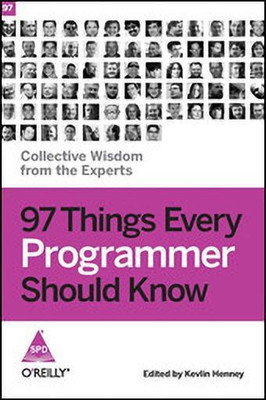97 Things Every Programmer Should Know(English, Paperback, Henney Kevlin)
Quick Overview
Product Price Comparison
Tap into the wisdom of experts to learn what every programmer should know, no matter what language you use. With the 97 short and extremely useful tips for programmers in this book, you'll expand your skills by adopting new approaches to old problems, learning appropriate best practices, and honing your craft through sound advice. With contributions from some of the most experienced and respected practitioners in the industry--including Michael Feathers, Pete Goodliffe, Diomidis Spinellis, Cay Horstmann, Verity Stob, and many more--this book contains practical knowledge and principles that you can apply to all kinds of projects. A few of the 97 things you should know: "Code in the Language of the Domain" by Dan North "Write Tests for People" by Gerard Meszaros "Convenience Is Not an -ility" by Gregor Hohpe "Know Your IDE" by Heinz Kabutz "A Message to the Future" by Linda Rising "The Boy Scout Rule" by Robert C. Martin (Uncle Bob) "Beware the Share" by Udi Dahan About The Author Kevlin Henney is an independent consultant and trainer. His work focuses on patterns and architecture, programming techniques and languages, and development process and practice. He has been a columnist for various magazines and online publications, including The Register, Better Software, Java Report, CUJ, and C++ Report. Kevlin is co-author of two volumes in the Pattern-Oriented Software Architecture series: A Pattern Language for Distributed Computing and On Patterns and Pattern Languages. He also contributed to 97 Things Every Software Architect Should Know. Table of Contents Chapter 1. Act with Prudence Chapter 2. Apply Functional Programming Principles Chapter 3. Ask, "What Would the User Do?" (You Are Not the User) Chapter 4. Automate Your Coding Standard Chapter 5. Beauty Is in Simplicity Chapter 6. Before You Refactor Chapter 7. Beware the Share Chapter 8. The Boy Scout Rule Chapter 9. Check Your Code First Before Looking to Blame Others Chapter 10. Choose Your Tools with Care Chapter 11. Code in the Language of the Domain Chapter 12. Code Is Design Chapter 13. Code Layout Matters Chapter 14. Code Reviews Chapter 15. Coding with Reason Chapter 16. A Comment on Comments Chapter 17. Comment Only What the Code Cannot Say Chapter 18. Continuous Learning Chapter 19. Convenience Is Not an -ility Chapter 20. Deploy Early and Often Chapter 21. Distinguish Business Exceptions from Technical Chapter 22. Do Lots of Deliberate Practice Chapter 23. Domain-Specific Languages Chapter 24. Don't Be Afraid to Break Things Chapter 25. Don't Be Cute with Your Test Data Chapter 26. Don't Ignore That Error! Chapter 27. Don't Just Learn the Language, Understand Its Culture Chapter 28. Don't Nail Your Program into the Upright Position Chapter 29. Don't Rely on "Magic Happens Here" Chapter 30. Don't Repeat Yourself Chapter 31. Don't Touch That Code! Chapter 32. Encapsulate Behavior, Not Just State Chapter 33 Floating-Point Numbers Aren't Real Chapter 34. Fulfill Your Ambitions with Open Source Chapter 35. The Golden Rule of API Design Chapter 36. The Guru Myth Chapter 37. Hard Work Does Not Pay Off Chapter 38. How to Use a Bug Tracker Chapter 39. Improve Code by Removing It Chapter 40. Install Me Chapter 41. Interprocess Communication Affects Application Response Time Chapter 42. Keep the Build Clean Chapter 43. Know How to Use Command-Line Tools Chapter 44. Know Well More Than Two Programming Languages Chapter 45. Know Your IDE Chapter 46. Know Your Limits Chapter 47. Know Your Next Commit Chapter 48. Large, Interconnected Data Belongs to a Database Chapter 49. Learn Foreign Languages Chapter 50. Learn to Estimate Chapter 51. Learn to Say, "Hello, World" Chapter 52. Let Your Project Speak for Itself Chapter 53. The Linker Is Not a Magical Program Chapter 54. The Longevity of Interim Solutions Chapter 55. Make Interfaces Easy to Use Correctly and Hard to Use Incorrectly Chapter 56. Make the Invisible More Visible Chapter 57. Message Passing Leads to Better Scalability in Parallel Systems Chapter 58. A Message to the Future Chapter 59. Missing Opportunities for Polymorphism Chapter 60. News of the Weird: Testers Are Your Friends Chapter 61. One Binary Chapter 62. Only the Code Tells the Truth Chapter 63. Own (and Refactor) the Build Chapter 64. Pair Program and Feel the Flow Chapter 65. Prefer Domain-Specific Types to Primitive Types Chapter 66. Prevent Errors Chapter 67. The Professional Programmer Chapter 68. Put Everything Under Version Control Chapter 69. Put the Mouse Down and Step Away from the Keyboard Chapter 70. Read Code Chapter 71. Read the Humanities Chapter 72. Reinvent the Wheel Often Chapter 73. Resist the Temptation of the Singleton Pattern Chapter 74. The Road to Performance Is Littered with Dirty Code Bombs Chapter 75. Simplicity Comes from Reduction Chapter 76. The Single Responsibility Principle Chapter 77. Start from Yes Chapter 78. Step Back and Automate, Automate, Automate Chapter 79. Take Advantage of Code Analysis Tools Chapter 80. Test for Required Behavior, Not Incidental Behavior Chapter 81. Test Precisely and Concretely Chapter 82. Test While You Sleep (and over Weekends) Chapter 83. Testing Is the Engineering Rigor of Software Development Chapter 84. Thinking in States Chapter 85. Two Heads Are Often Better Than One Chapter 86. Two Wrongs Can Make a Right (and Are Difficult to Fix) Chapter 87. Ubuntu Coding for Your Friends Chapter 88. The Unix Tools Are Your Friends Chapter 89. Use the Right Algorithm and Data Structure Chapter 90. Verbose Logging Will Disturb Your Sleep Chapter 91. WET Dilutes Performance Bottlenecks Chapter 92. When Programmers and Testers Collaborate Chapter 93. Write Code As If You Had to Support It for the Rest of Your Life Chapter 94. Write Small Functions Using Examples Chapter 95. Write Tests for People Chapter 96. You Gotta Care About the Code Chapter 97. Your Customers Do Not Mean What They Say Appendix. Contributors Colophon.


